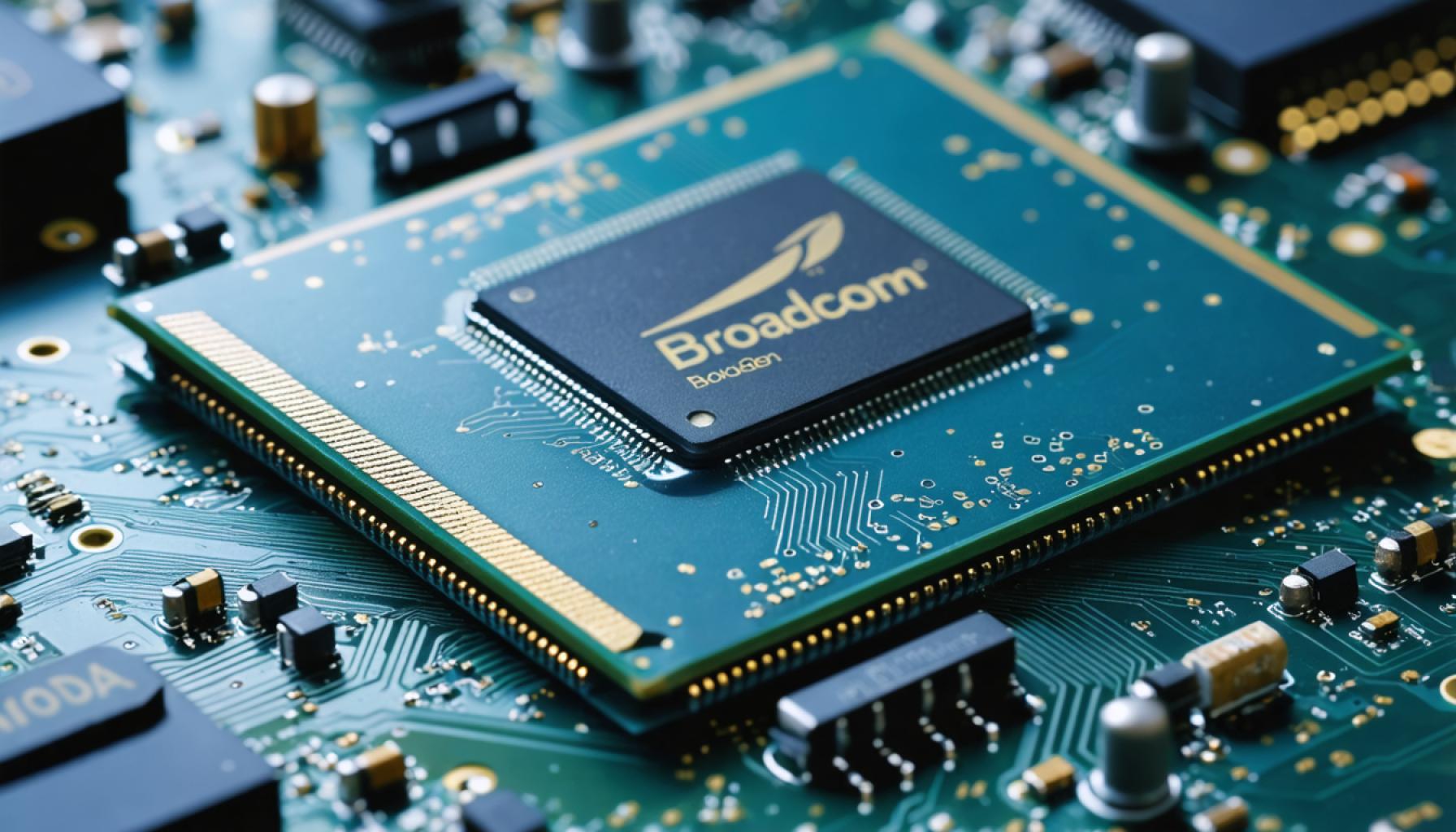- Broadcom emerges as a strong contender in AI technology with its innovative XPUs, challenging Nvidia’s dominance.
- XPUs offer specialized, high-efficiency performance for specific AI workloads, trading versatility for speed and precision.
- The market potential for XPUs is substantial, with forecasts predicting growth to $60-$90 billion by 2027.
- Broadcom’s growth is supported by existing contracts and new partnerships, reinforcing its positive outlook.
- Challenges include potential geopolitical risks such as tariffs on semiconductor imports from Taiwan.
- Broadcom’s expected revenue growth positions it favorably in the market, with potential to outperform the S&P 500.
- The company’s strategic push into AI marks a critical phase in the evolving landscape of computing innovation.
In the swirling maelstrom of financial markets, where artificial intelligence stocks experience a tempestuous period, Broadcom emerges as a beacon of opportunity. This tech titan, known for its multifaceted business ventures, shakes the status quo with a pioneering approach to AI technology. Broadcom’s endeavor into custom AI accelerators, branded as XPUs, promises to redefine the market by challenging Nvidia’s long-standing prowess.
Visualize a world where GPUs, the workhorse of AI computing, are not the sole gladiators in the arena. Broadcom’s XPUs offer a specialized alternative. These chips, sculpted for precision, excel in specific workloads like training AI models with astonishing efficiency. Their streamlined architecture sacrifices the Swiss-army-knife flexibility of Nvidia’s GPUs but, in return, delivers unrivaled performance for particular tasks. This strategic trade-off, embraced eagerly by AI hyperscalers, heralds a new era of computing innovation.
The economic landscape Broadcom navigates is gilded with potential. Management forecasts an explosive market size for XPUs, anticipating it to soar between $60 billion and $90 billion by 2027. The journey started humbly with $12.2 billion in revenue for this unit in 2024, yet the lustrous horizon is within reach.
Underscoring this optimism are negotiations with three foundational clients, alongside alliances with new partners poised to unleash their inaugural XPU designs. This burgeoning client base is more than a statistical forecast; it is the cornerstone of Broadcom’s bullish growth trajectory.
However, the path to innovation is not devoid of hurdles. The shadow of tariffs, particularly on semiconductor imports from Taiwan, hovers ominously. Although current exemptions stave off potential cost increases, the geopolitical tightrope remains fraught with uncertainty.
Yet, the allure of Broadcom extends beyond mere XPUs. An expected doubling of company revenue, from a robust $54 billion over the past year, positions the stock to command a premium in financial circles. In stark contrast to the S&P 500’s ebb, Broadcom’s trajectory promises a vigorous swell in total returns.
In this tempest of technological advancement and economic fluctuation, Broadcom’s audacity to challenge Nvidia marks a pivotal moment. As the allure of AI continues to galvanize markets and capture imaginations, the race for superior computing will chart new frontiers. Broadcom stands at the cusp, poised to illuminate a path forward in the AI renaissance.
Why Broadcom’s XPUs Could Be the Next Big Thing in AI Computing
Understanding the Broadcom and Nvidia Dynamics
Broadcom’s entry into the world of AI computing marks a significant shift in the industry landscape. Traditionally dominated by Nvidia’s GPUs, the market is now poised for fresh competition with Broadcom’s introduction of XPUs. These custom AI accelerators are engineered for specific workloads, offering potential advantages in performance and cost-effectiveness for certain applications.
What Sets Broadcom’s XPUs Apart?
1. Specialized Architecture: Unlike Nvidia’s GPUs, which provide broad functionality, Broadcom’s XPUs are tailored for distinct AI tasks. This specialized design means they can deliver enhanced performance for tasks such as neural network training, which might be more efficient than using a GPU.
2. Efficiency and Cost: XPUs are expected to be more energy-efficient for specific workloads, thereby potentially reducing operating costs. As businesses increasingly focus on sustainability, such efficiencies become crucial.
3. Strategic Partnerships: Broadcom’s alliances with foundational clients and new partners for XPU designs underscore its commitment to becoming a formidable player in the AI market. These collaborations are critical for accelerating innovation and adoption.
Market Forecast and Industry Impact
– Market Potential: The market for XPUs is forecasted to reach between $60 billion and $90 billion by 2027. This aligns with the broader trend of AI’s growing significance in both consumer and enterprise applications, highlighting a lucrative opportunity for Broadcom.
– Client Growth: Broadcom is actively negotiating with key clients, which will enhance its market penetration. Its strategic engagements serve as a testament to the growing interest in alternative AI solutions beyond GPUs.
Challenges and Geopolitical Considerations
While Broadcom navigates a promising landscape, it’s not without challenges. Geopolitical tensions and tariffs, particularly concerning semiconductor imports from Taiwan, could impact cost and supply. Maintaining exemptions or finding alternative solutions will be pivotal for steady growth.
Broader Financial Outlook
Broadcom anticipates doubling its revenue, expecting momentum from its diverse ventures. This growth is notable against the backdrop of the broader market, positioning Broadcom’s stock as an appealing option for investors seeking robust returns.
Actionable Recommendations for Investors and Industry Stakeholders
– Monitor Industry Trends: Keeping an eye on technological advancements in AI computing can help investors make informed decisions.
– Evaluate Energy Efficiency: As sustainability becomes a pressing concern, the energy efficiency of XPUs can be a significant factor in adoption rates.
– Stay Informed on Regulatory Changes: Staying updated on trade policies and tariffs, especially those affecting key components, can help mitigate risks.
For more on tech and innovation, consider visiting Broadcom. Broadcom’s journey into AI computing evolution is a space to watch, blending precision engineering with strategic foresight. As AI continues its transformative journey, the choices companies make today, like those of Broadcom, will have enduring impacts.
Quick Tips for Immediate Application
– Diversify Investments: Look at tech companies like Broadcom that are challenging industry norms.
– Tech Adoption: Business leaders should consider the specific advantages of XPUs for AI-related tasks, ensuring cost and energy efficiency where applicable.
– Prepare for Geopolitical Shifts: Businesses reliant on imports should develop contingency plans to counteract potential disruptions.






